In January 2016, I attended Tate Britain’s Artist and Empire: Facing Britain’s Imperial Past, a disappointing exhibition that in spite of its title did not face Britain’s past in any meaningful way. On the contrary, as I argued in my review, it shied away from this bloody history in favour of quasi-glorification, non-committal wording and vague descriptions that resulted in an exhibition sorely lacking any critical analysis of the realities of colonialism and imperial rule. A few days after I visited this exhibition, the results of a survey concerning the UK public’s attitude towards the British Empire were announced. This survey found that 44 percent of the public were proud of their country’s colonial past and 43 percent believed that the British Empire was a good thing. A similar survey in 2014 discovered that a staggering 59 percent of the public believed that the Empire was something to be proud of and that 34 percent would like it if Britain still had one; a paltry 19 percent saw it as something to be ashamed of. With these statistics in mind, I began to think about how Britain’s violent past, as well as its present, is portrayed in other museums and cultural institutions around the country and how these depictions may have contributed to the public holding such ill-informed ideas about Britain’s history of imperialism. Aware that I had not visited the Imperial War Museum since a school trip there almost two decades ago, I decided to visit its main site in South London in order to discover how it depicts the violence of Britain and the British Empire. The IWM, as the museum is now known, re-opened in 2014 after an extensive £40m refurbishment funded by — amongst others — Lord Ashcroft, Sir David Barclay (owner of the Daily Telegraph), Lord Rothermere (owner of the Daily Mail) and Evgeny Lebedev (owner of the Evening Standard and the Independent). Spotting the names of this assortment of Conservative Party donors and media mogul billionaires listed prominently as funders of the museum did not serve to increase my expectations of how it would portray Britain’s role in the world. What I discovered upon my visit in April 2016 was a confusing mixture of typical — at times blatant — state-friendly propaganda in the museum’s permanent galleries, and something very different and unexpected in its temporary exhibition space.
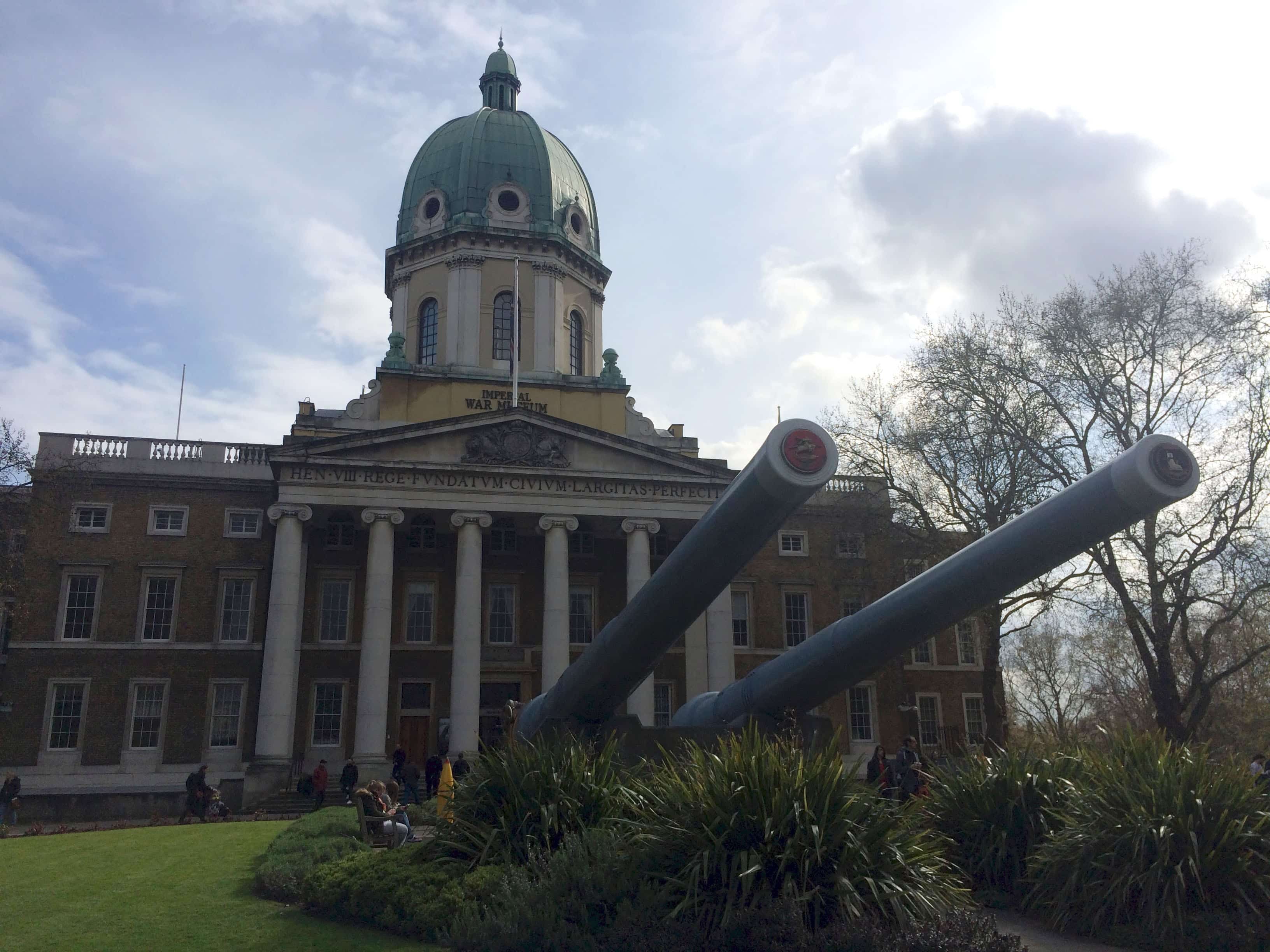
Imperial War Museum, London, April 2015. Photo by Louis Allday.
A striking aspect of the IWM, particularly so given its name, is the glaring lack of references to British Imperial warfare it contains. Aside from a few cursory references to conflicts related to the end of Empire and the transition towards the Commonwealth, the British Empire is conspicuously absent from much of the museum. A notable exception to this tendency appears in the Lord Ashcroft Gallery, an eponymously named permanent exhibit on the museum’s top floor that was funded by a £5m donation from the Tory peer. The gallery houses Ashcroft’s personal collection of Victoria Crosses, Britain’s highest military honour that is awarded for “gallantry in the face of the enemy”. As I made my way around the gallery, I noticed almost immediately that many of the medals were from the same two year period: 1857-58. It was in these two years that Britain crushed what was perhaps the greatest anti-colonial military rebellion in history, one conducted against the rule of the East India Company in India. Unfortunately, the descriptions of the “extraordinary heroes” who participated in brutally quelling this rebellion consist of entirely unapologetic celebrations of their supposed heroics, the men’s respective body counts of “rebel Indian soldiers” are tacitly celebrated and their “aggressive bravery” is praised. The tone of the captions is regrettably similar to that of the Boy’s Own-style comics with which the gallery is oddly decorated.
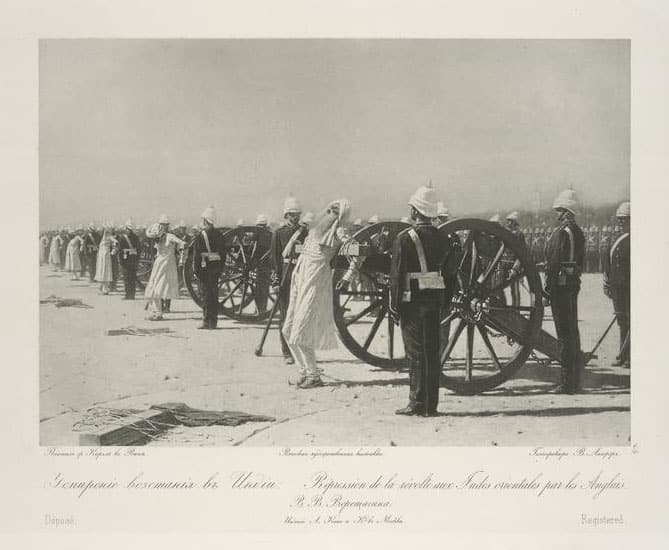
“Usmirenie vozstaniia v Indii. V.V. Vereshchagina”
[Supression of Rebellion in India, Vasily Vereshchagin],
Slavic and East European Collections, New York Public Library Digital Collections.
Other medals contained in the gallery include one that was awarded to Lieutenant Robert Rogers for his actions at the Battle of Taku Forts in 1860. The caption for the medal provides no explanation or context regarding this battle’s exact location or its historical significance. From my own research, I discovered that it occurred in the North-East of China and was the last major engagement of the Second Opium War (1856-1860). The fact that Rogers’ bravery took place during an especially sordid war of aggression that was waged not only to enforce Britain’s sale of opium produced in India upon a beleaguered Chinese population against the wishes of the Chinese Government, but also to force the country open to British merchants and to make foreign importers exempt from internal transit dues, is left entirely unmentioned. During the First Opium War (1839-1842), Britain’s actions in China were described by Thomas Arnold as “so wicked as to be a national sin of the greatest possible magnitude”; the renowned educator and historian believed that in all of history, no war had been undertaken “with such combined injustice and baseness”.1 Yet in the Ashcroft Gallery, the Opium Wars’ only significance is to serve as the unacknowledged backdrop to the ostensibly heroic violence of a British military officer.
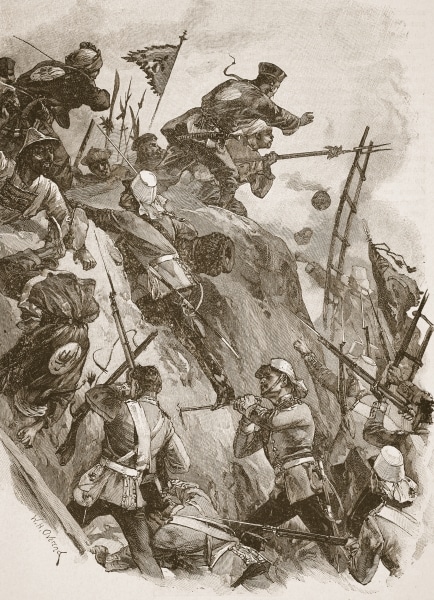
“British troops storm the Taku Forts, China, in 1860,
in Second Opium War,” 1860.
Another medal contained in the gallery is one received by Lieutenant Augustus Agar for his role in a “daring” raid on a Russian cruiser near Kronstadt harbour in Russia in 1919. Once again, no historical context of the incident is provided in the caption. It is left unsaid that Agar was in fact fighting as part of a reactionary multi-national force (including the USA, France, Japan, Italy and Czechoslovakia) that had been sent to Russia in order to try and crush the Bolshevik Revolution. Another medal relates to the actions of Lieutenant-Colonel John McNeill in New Zealand in 1864, as a part of Britain’s brutal campaign of territorial expansion and suppression of the indigenous Maori population that is now referred to as the New Zealand Wars (1845-1872). In sum, the entire gallery openly and shamelessly celebrates Britain’s imperial violence and provides little or no historical context to it. The British Empire’s repressive, reactionary and frequently vicious role in the world is thus completely obscured. This celebratory stance is perfectly encapsulated in one of several large captions dotted around the exhibition that glorify the supposedly ideal characteristics of bravery and leadership; the caption is titled ‘Aggression’ and reads as follows: “Strike now while the iron’s hot. Use maximum force. For these people, killing is a means to an end. It’s hot courage, adrenalin driven in the heat of the battle. If you don’t get them — they’ll get you”. Unfortunately, the Ashcroft Gallery is not unique — on the contrary, although other exhibits in the museum provide more historical context, their portrayal of more recent conflicts is equally distorted.
Perhaps the most chilling object on display in the entire museum is one of five shell casings that were constructed for Little Boy, the atomic bomb that was dropped on Hiroshima by the US Air Force on 6 August 1945. This item — lent to the museum by the US Government — forms part of an area of the museum that is dedicated to the history of nuclear weapons and the Cold War. The opening text of this area, entitled ‘Shadow of the Bomb’, is typical of much of what is wrong with the IWM and is so staggeringly misleading that it is worth analysing in detail. Tellingly, when this text describes the destruction of Hiroshima and Nagasaki, it uses the passive voice, so that the two cities are described as simply having been “destroyed by two atomic bombs”; no perpetrator is identified at all. In fact, if a reader were somehow unaware that it was the USA that had actually destroyed these two Japanese cities, as a child might be for instance, it would not be clear from the IWM’s choice of wording exactly who was responsible. The text goes on to state that “[a]t first America and Britain saw this [the atomic bomb] as just a powerful weapon. But by 1949 a now hostile Soviet Union had its own bomb. The world faced the prospect of all-out nuclear war”. The sub-text is obvious, in spite of the fact that the US military had already used nuclear weapons in 1945 and in so doing had slaughtered hundreds of thousands of Japanese civilians, the USA and Britain possessing them was seemingly not the problem; it was only in 1949 when the Soviet Union gained its own nuclear capability that the threat truly began and the atomic bomb was elevated from being “just another weapon” to the invention that made the prospect of global nuclear annihilation a reality. Bizarrely, the text then completely ignores the annihilation of Hiroshima and Nagasaki mentioned just two paragraphs earlier, and states “If they [nuclear weapons] were ever used, the consequences could be devastating”, as if the world had not already witnessed exactly how devastating the consequences were. Of course, the fact that there was no military need to drop the bombs, and a desire to demonstrate their awesome destructive power to the world — especially the Soviet Union — was actually a significant factor behind the USA’s decision to use them at that juncture, is predictably left unsaid.2 The museum also contains other, more blatant, revisionist falsehoods related to this period, including the contention that the US had “introduced democracy” in the South of Korea after the Second World War and that the subsequent Korean War was “a political war: communism v. democracy”. The curators appear to have forgotten that free elections were not held in South Korea until many decades after the war, and that until 1960 the country was ruled by Syngman Rhee, an authoritarian, anti-Communist strongman who had been virtually handpicked by the US for the role.
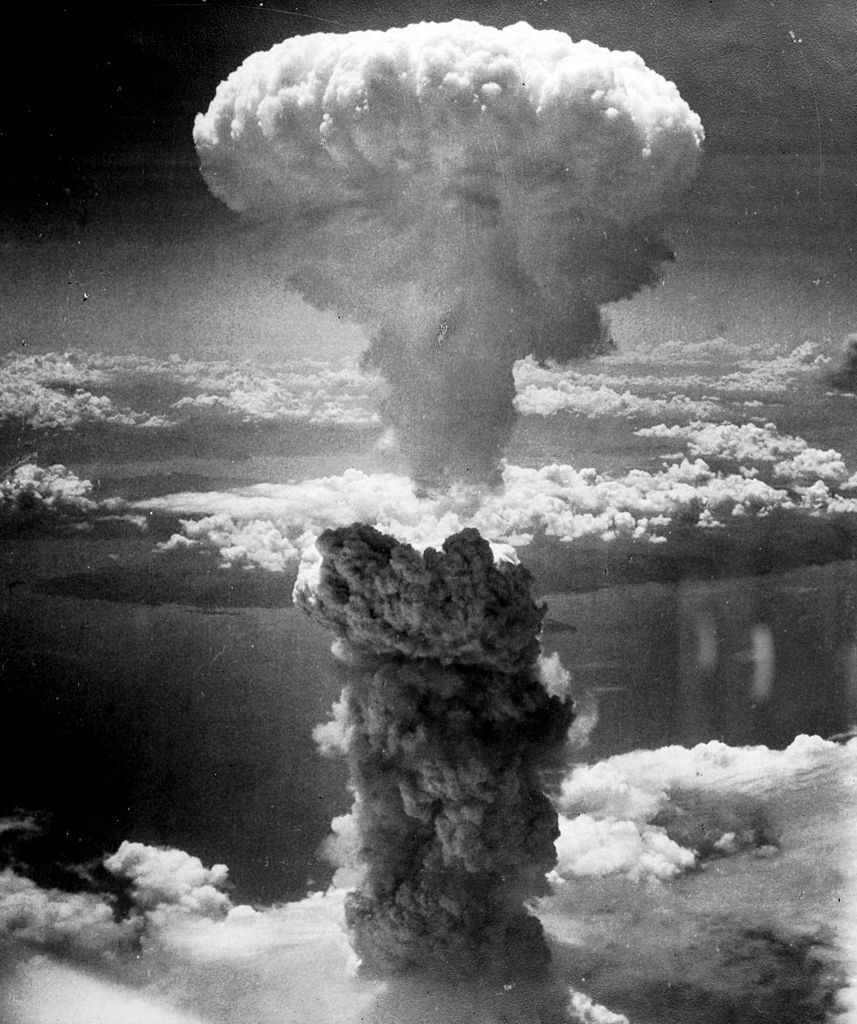
Mushroom cloud above Nagasaki after atomic bombing
on August 9, 1945. Photo by Charles Levy
from one of the B-29 Superfortresses
used in the attack. National Archives.
In a manner reminiscent of how the Artist and Empire exhibition portrayed violence committed by and against the British Empire in very different ways, it is revealing to compare how violence committed by and against the USA is described at the IWM. The museum has an area dedicated to the September 11 attacks that contains a steel window frame that was taken from the north tower of the World Trade Centre in New York. The text that appears next to this display is highly emotive in tone and replete with adjectives. The “burnt and twisted metal” of the window frame is said to “graphically” express the “sickening violence that destroyed the buildings” and the “devastating nature” of the attacks are stressed; it is explained that the “violence of the assault” and “the vulnerability of ordinary people going about their lives shocked the world”. This remarkably plaintive description stands in marked contrast to the matter-of-fact tone in which the nuclear devastation of Hiroshima and Nagasaki is described: “Fuelled by enriched uranium, the bomb resulted in a massive nuclear explosion that destroyed 90 percent of the city and killed 70,000 people. Three days later, a second plutonium fuelled bomb known as ‘Fat Man’ was dropped on Nagasaki. A further 39,000 Japanese died”. By virtually any measure imaginable, the bombing of Hiroshima and Nagasaki was significantly more shocking, unprecedented and bloody than the September 11 attacks, the respective death tolls of the two (c. 3,000 to c. 250,000 in total) are an indication of the scale of this disparity. This begs the question: why is only the more recent event denounced and depicted in such affecting terms?
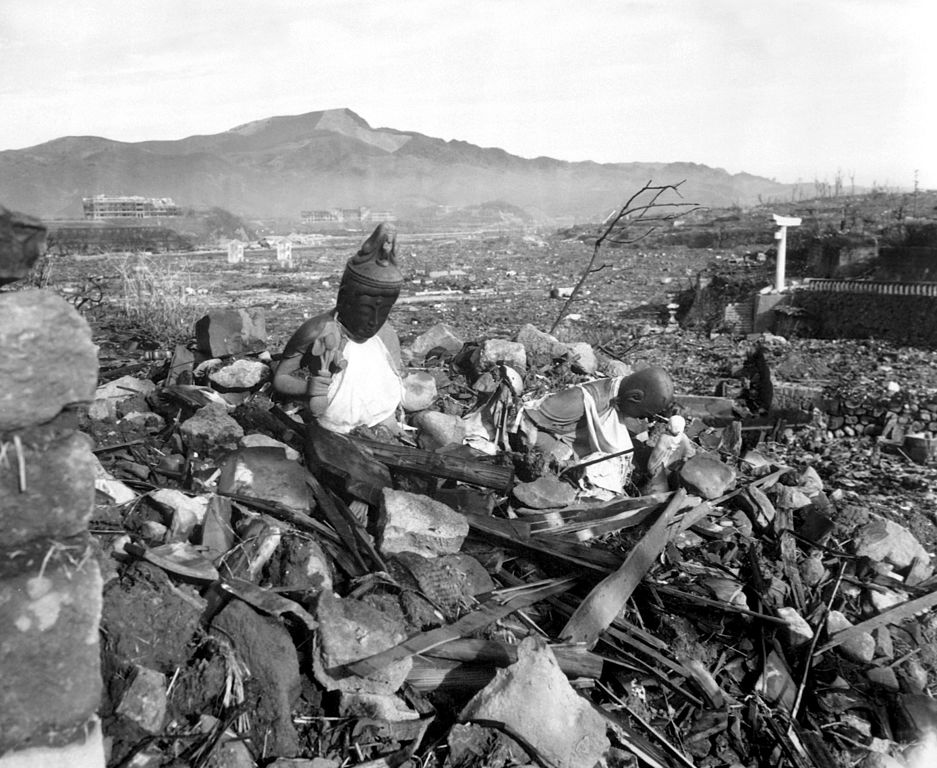
Battered religious figures stand watch on a hill above a tattered valley,
Nagasaki, Japan, September 24, 1945, 6 weeks after the city was destroyed
by the world’s second atomic bomb attack.
Photo by Cpl. Lynn P. Walker, Jr. (Marine Corps). National Archives.
Similarly, the US/UK invasion of Iraq in 2003 — aptly described by Harold Pinter in 2005 as “an act of blatant state terrorism, demonstrating absolute contempt for the concept of international law” — also receives remarkably light treatment at the IWM. The closest it comes to criticism is when the text below an anti-war poster depicting Tony Blair states “millions of people across the world did not believe the American reasons for invading Iraq in 2003. They felt the action was wrong”. However, no further context is given and the more prominent introductory text to the section states that “the official aims of the 2003 war were to destroy any weapons of mass destruction in Iraq, break Saddam’s links with global terrorism and to free the Iraqi people”; the fact that these aims were all untrue is simply not commented upon. The broader context of the war, i.e. the UN’s genocidal sanctions regime, which was imposed upon Iraq for over a decade before the invasion and the country’s enormous oil supplies, is also absent.
Generally, the portrayal of both Britain and the USA throughout the museum’s permanent galleries reflects the ruling class consensus of these two states being responsible, well-intentioned global powers. For instance, Britain is said to have sent its military to Northern Ireland merely to “help the police keep order” and British soldiers are presented as innocent bystanders simply “trying to keep the peace and strike a balance between the two fiercely divided communities”. An area of the museum that discusses Britain’s role in the post Second World War era does acknowledge that it “was determined to remain a world power, with a global empire and international responsibilities”. However, the main blurb for the post-1945 section of the museum ignores this and instead offers the following ahistorical platitude as its solitary explanation for the world’s conflicts since the Second World War: “The world is a violent place. Arguments about who people are, what they believe and how they should run their lives quickly spill over into direct confrontations. Within individual communities, friends and neighbours can become enemies. The resulting hatred often leads to bitter fighting, destruction and death”. The concrete reasons behind conflicts since the Second World War — namely the imperialistic impulse for the control of resources and territory and the intimately connected need to enforce the US-led capitalist system globally — are thus buried behind a trite façade of arguments between individuals and a notion that the world is somehow inherently “violent” without identifiable causes. This apolitical and frequently misleading tone is demonstrated perfectly by the museum’s text regarding NATO’s war against Serbia in 1999. This description makes no mention at all of the broader context and political motivations behind NATO’s dismemberment of Yugoslavia, and instead explains the hostility between Kosovars and Serbs simply by reference to the Battle of Kosovo Polje in 1389 and the presumably primordial ethnic hatred that has existed between the two groups ever since. When NATO is briefly mentioned, it is presented as an altruistic saviour that created “an area of safety for the people of Kosovo” against Serbian aggression with no further details given. Unsurprisingly, the prominent role that Britain’s Special Forces and intelligence services played in arming and financing the Kosovo Liberation Army, an al-Qaeda linked terrorist organisation, is not discussed.
In an area of the museum that details the development of MI5 (Britain’s internal intelligence service) a number of pamphlets, photographs and newspapers are displayed together in a large glass cabinet. These items ostensibly represent the various threats which Britain faced after the First World War that served to justify MI5’s domestic espionage activities. As such, the cabinet contains the incongruous combination of photographs of Adolf Hitler and issues of the British Union of Fascists’ newspaper, Blackshirt, alongside a copy of the Communist Manifesto and leftist pamphlets with slogans including ‘London’s millions against London’s millionaires’. The message behind the curatorial decision to include these pamphlets immediately side by side is unambiguous; Nazism/Fascism and Communism are directly comparable and both were internal threats from which MI5 had to protect the British public. The display is a crude physical manifestation of the so-called ‘Horseshoe Theory’: the argument that the far-right and far-left, rather than being on opposite ends of the political spectrum, actually closely resemble one another (like the ends of a horseshoe). This dishonest conflation of two fundamentally different ideologies has been prominent in both US and UK political discourse of late, with numerous commentators directly conflating Jeremy Corbyn and Donald Trump, and explaining the popularity of both in identical terms. For good measure, the display case also contains items related to Sinn Fein and Irish Nationalism, thus tainting that cause by direct association with Nazism too. Unfortunately, this exhibit’s benign representation of MI5 and its tacit demonization of Communism and the Irish Nationalist cause are not unique. On the contrary, this attitude is representative of the tone of much of the content of the museum’s permanent galleries.

“C” Squadron (Rhodesian) SAS in 1953, in Malaya, 1953
A section of the museum entitled ‘Secret Soldiers’ that follows the MI5 display, unashamedly venerates Britain’s elite special forces unit, the Special Air Service (SAS), for its “skill and determination” in “confront[ing] communist guerrillas” in the so-called Malayan Emergency (1948-1960). This heroic picture hides a different reality: that Britain’s supposed anti-insurgency operation in Malaya was in fact a brutal war of mass murder, aerial bombardment (including the use of chemical weapons), torture and collective punishment, which was waged ruthlessly against the local population in order to ensure British companies maintained ownership and control of the region’s natural resources, notably its rubber and tin. This shameful episode, though far from unique, is described in grim detail by the historian Mark Curtis in this piece, in which he quotes a British conscript who served in Malaya recalling that “when we had an officer . . . out with us on patrol I realised that he was only interested in one thing: killing as many people as possible”.
The role of the SAS in Oman is similarly white-washed by the exhibit’s text, which describes the force’s interventions in the Jabal al-Akhdar revolt in the 1950s and in the later Dhufar Revolution. According to the text, in 1970, the SAS helped to defend Dhufar “against Yemeni-backed rebels” and used its “tried and trusted ‘hearts and minds’ policy” to win over the local population and defeat the rebels. According to Professor Abdel Razzaq Takriti, author of Monsoon Revolution: Republicans, Sultans, and Empires in Oman, 1965-1976, the notion that the SAS won over the local population in this manner is “pure propaganda” which ignores that the strategy it utilised was “premised on augmenting and enhancing internal social divisions and fostering what amounted to an internal civil war within Dhufar”. Takriti also comments that by reducing the Dhufari revolutionaries to “Yemeni-backed rebels”, the IWM text totally obscures the popular character of the revolution; the reader is not told that Dhufar was actually being ‘defended’ against its own people on behalf of a pro-British “monarchical regime that was becoming increasingly absolutist in character”. Takriti concludes that ultimately “the role of the SAS as a fundamentally colonial force is completely ignored” by the text.
On the day of my visit, the museum’s main galleries were crowded with families and I found myself depressed at the thought of the thousands of school children who visit the museum every year being exposed to such an inaccurate and manipulative depiction of Britain’s recent past. After all, ideas instilled in a person’s mind at such a young age often become so deeply engrained as to become conceptualized merely as ‘common sense’ as opposed to a specific and self-serving set of ideas propagated by the ruling class. Notwithstanding this depressing thought, on the museum’s third floor, I found something that served to complicate my impression of the institution as a whole and provided a small but welcome relief from the barrage of propaganda that I had faced elsewhere in the museum. At the time of my visit, the IWM was hosting a retrospective of the artist Peter Kennard entitled Unofficial War Artist. The exhibition — which ran from May 2015 until May 2016 — contained a wide selection of Kennard’s work dating from the 1960s to the present day. Ironically, Kennard’s retrospective confronted many of the themes that are so noticeably absent from the museum’s permanent galleries. Indeed, as Kennard told me in his North London studio in July 2016, the opening piece of his show, Decoration, was chosen by him as a direct riposte to the medals so uncritically displayed by the IWM in the Ashcroft Gallery.
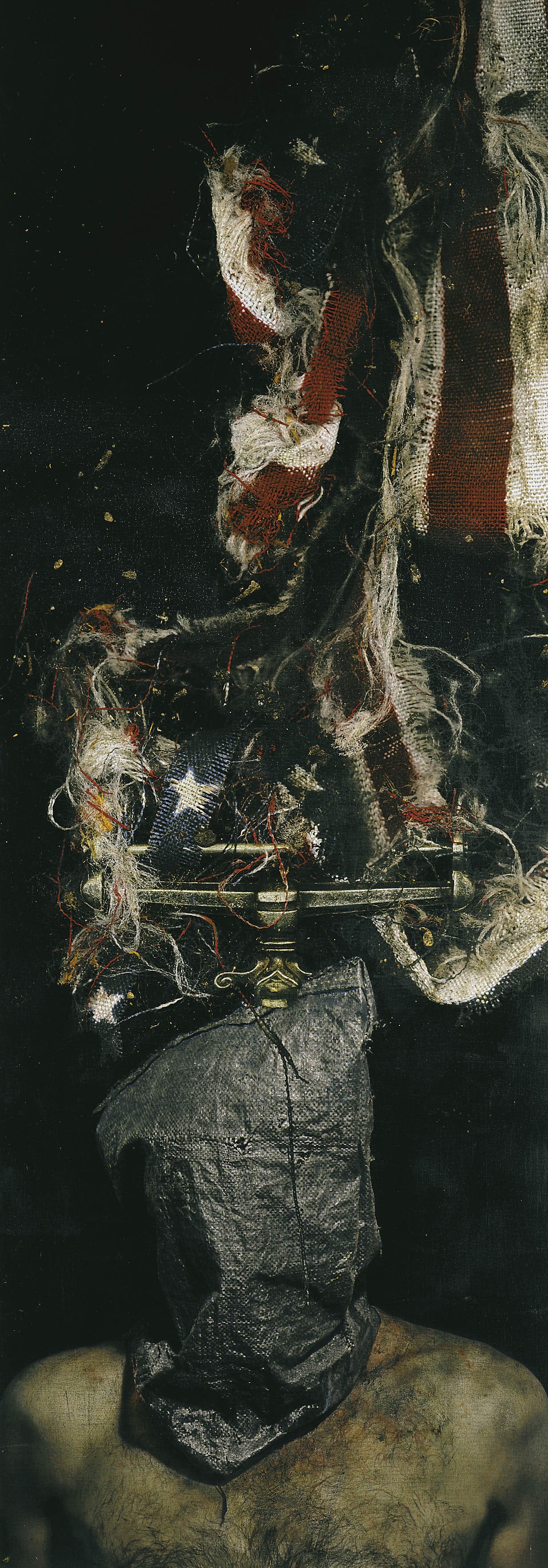 |
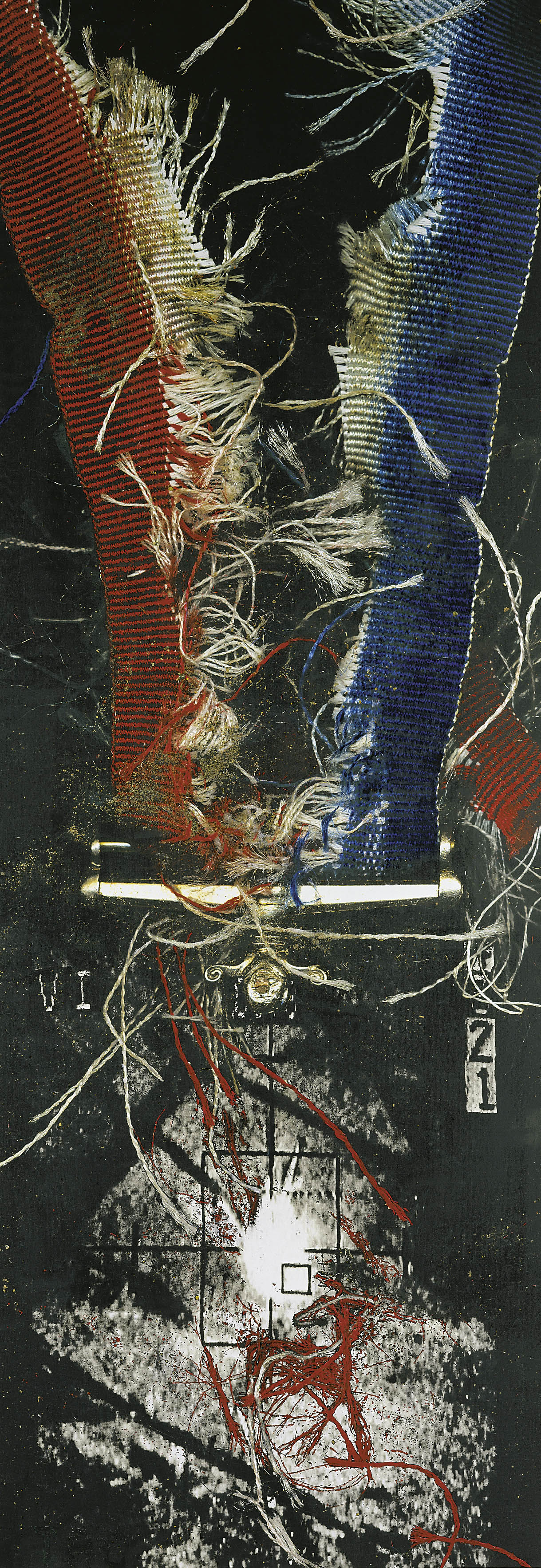 |
| Details from Decoration by Peter Kennard (2003/4). © Peter Kennard | |
The six large paintings that form Decoration were created by Kennard between 2003 and 2004 as a direct response to the US/UK invasion of Iraq. Created through a combination of digital printing and oil painting, they show ripped and frayed flags and ribbons of British and American medals, with each medallion replaced with a different image. These images include a charred body amidst burnt out ruins, the bandaged faces of war victims, a military helmet with kill notches marked on it and — in what is an obvious and potent reference to the US military’s sickening abuses at Abu Ghraib prison — a hooded head and naked torso.
Alongside numerous works produced by Kennard over the last five decades, including many powerful pieces that he made for the Campaign for Nuclear Disarmament during the 1970s and 1980s, his IWM retrospective also contained a newly-created installation named Boardroom. According to the exhibition’s press release, Boardroom “delivers a disturbing message about inequality, wealth disparity and skewed priorities in the twenty-first century as basic human compassion is routinely overshadowed by corporate interests and the rivalries of richer nations”. The installation, more didactic and text-based than some of Kennard’s other work, makes very effective use of images and statistics. The statistics chosen by the artist not only juxtapose the enormous disparity in death tolls of various conflicts, but also make explicit the connections between hunger, inequality and war — the nexus of capitalism and imperialism. It is interesting to note that the death toll of the bombing of Hiroshima used by Kennard (140,000 quoting the Hiroshima Peace Memorial Museum) is double the unreferenced 70,000 figure given in the IWM’s permanent exhibition.
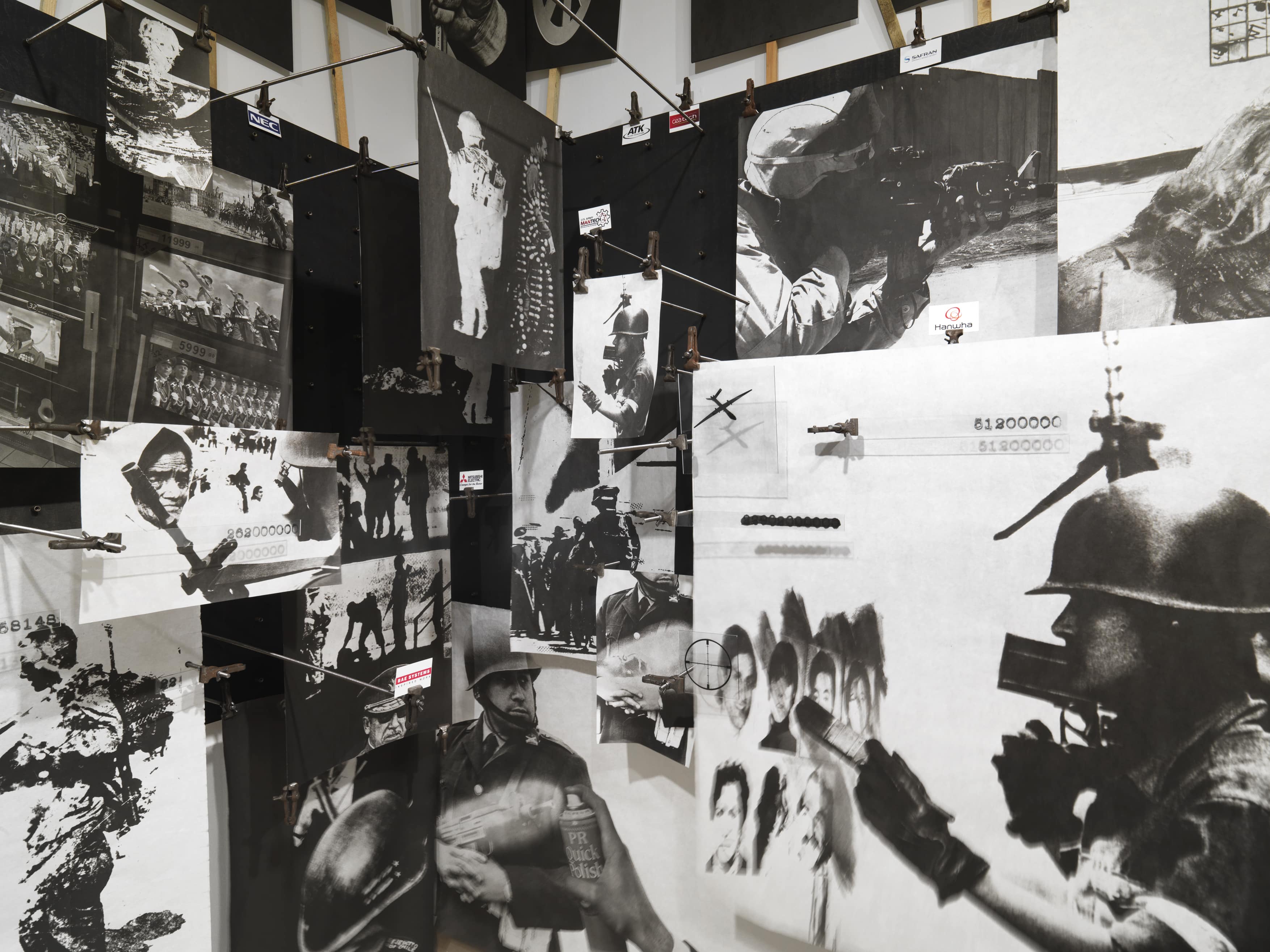
Detail from Boardroom by Peter Kennard (2015). © Peter Kennard
While reading these statistics, I overheard a middle-aged woman say to her friend “this is the best thing in the building”, a sentiment with which I agreed vocally. This positive reaction was heartening, but I could not help but notice that, on my visit at least, Kennard’s exhibition was sparsely attended in comparison to the museum’s other galleries. Regardless, Kennard’s work being displayed in an institution as prominent as the IWM undoubtedly opens it out to a broader audience, something which can only be positive. For Kennard, although conscious he does not want his work to become an “establishment thing”, the chance to display his work to such a large audience was an opportunity not to be missed. To do so in a museum, as opposed to in an art gallery, and therefore reach a different, non-art audience was also of particular appeal to Kennard, particularly as what he described as the “insidious self-censorship of curators” over the years has limited the number of galleries and institutions where he has been able to display his work. Kennard has also faced more overt censorship during his career, notably regarding one of his most widely known works, Photo Op, a 2005 photo-montage collaboration with Cat Phillips that depicts a manically grinning Tony Blair taking a photo of himself against a backdrop of a blazing oilfield. In 2013, IWM North, the museum’s branch in Manchester, chose Photo Op to illustrate a poster campaign for an exhibition about modern art and war. However, the advertising firms JCDecaux and CBS Outdoor, which between them control around 50-70% of outdoor advertising in the UK and the majority of sites in Manchester, refused to show the posters and IWM North was forced to entirely remove the image from its marketing plan.
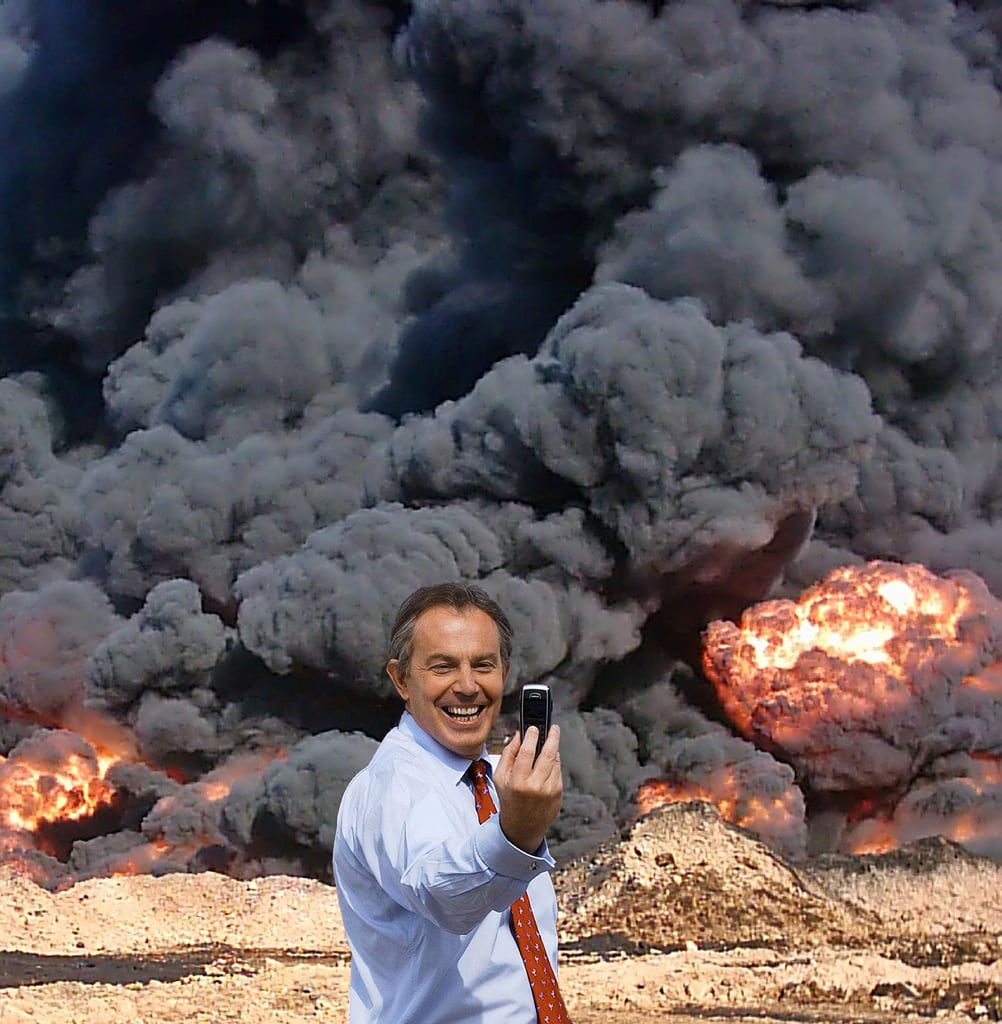
Photo Op by KennardPhillips (2005). © KennardPhillips
Kennard believes that being in a position to host his work so prominently is something that the IWM’s Art Department has worked on for some time and would not have been possible a number of years ago. It appears that the presence of Kennard’s work in the museum is testament to Richard Slocombe, its Senior Curator of Art, and other members of this department who clearly envisage a role for the museum beyond merely projecting a sanitised, inaccurate narrative of Britain’s role in war. The inclusion of voices such as Kennard’s, undoubtedly overdue, provides an important contrast to the tone of the museum’s permanent exhibitions. However, Kennard’s work — as the product of a single artist — may wrongly be dismissed by some as simply ‘art’, or the partisan opinions of one man. By contrast, the texts in the permanent exhibitions will be taken by many as historical facts: ostensibly neutral, incontrovertible and authoritative. Another crucial difference of course is that Kennard’s exhibition was only temporary, whereas the permanent galleries are just that, and as a result will be seen by — and will directly influence — infinitely more of the public. More broadly, there is also a danger that the IWM could point to its hosting of Kennard as a means to deflect and ultimately shut down legitimate criticism of the museum’s contents as a whole.

Winston Churchill As Prime Minister 1940-1945.
Photo by War Office Official Photographer Captain W.T. Horton. IWM
After I left Kennard’s retrospective, I walked out past the museum’s gift shop where, amongst numerous posters reflecting the ongoing and widespread nostalgia in Britain for an idealised 1940s, I saw one that depicted Winston Churchill — a man who while serving in Sudan shot at least five men3 whom he described as “simple-minded savages“4 — holding a Thompson submachine gun. Indeed, the IWM’s online gift shop actually has an entire section devoted to Churchill-related paraphernalia. This deep-rooted veneration, not to mention monetisation, of Churchill, callous racist that he was, speaks to the heart of the problem in this country. It is a damning indictment of the UK that Churchill remains widely cherished and in 2002 was even voted the ‘greatest Briton of all time’. As I walked out of the museum, past the enormous naval guns that sit in front of its main entrance, it struck me that until it is completely unthinkable for Churchill’s image to be marketed in this way, Britain will not have sufficiently come to terms with the reality of the British Empire and the role that ‘great’ men like Churchill played in the racist violence that was inherent to it. There is no doubt that a large and respected institution such as the IWM could play an important role in fostering this much needed shift in public consciousness. Although its inclusion of artists like Kennard is commendable, it is the museum’s larger permanent galleries that could have much more of an impact and are in such dire need of change; until this happens, the IWM will remain a part of the problem. To many living in contemporary Britain, the word propaganda immediately brings to mind the past, typically Nazi Germany or Soviet Russia. This narrow understanding of the word obscures the reality that propaganda in manifold forms remains all around us today, inside our museums and national institutions, within our educational curriculums, in our deceitful media and in corporate imagery that, in the words of Kennard, “has slid off the billboards into every crack and crevice of public space”.5 Therefore, as long as the IWM and other institutions remain intent on portraying such a sanitised and skewed history of Britain’s actions around the world, it is incumbent upon us to question and challenge their narratives.
1 Arthur Penrhyn Stanley, The Life and Correspondence of Thomas Arnold (1877) p. 376.
2 Gar Alperovitz, Atomic Diplomacy: Hiroshima and Potsdam – The Use of the Atomic Bomb and the American Confrontation with Soviet Power (1994)
3 Norman Rose, Churchill: An Unruly Life (1994) p. 39.
4 Th. A. van Baarda and D.E.M. Verweij, The Moral Dimension of Asymmetrical Warfare: Counter-terrorism, Democratic Values and Military Ethics (2009) p. 2.
5 Peter Kennard, Unofficial War Artist (2015) Afterword.
Louis Allday is a PhD candidate at SOAS based in London. Follow him on Twitter @Louis_Allday.
